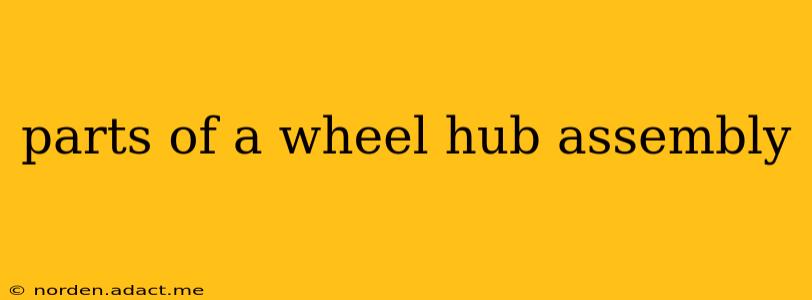The wheel hub assembly is a critical component of your vehicle, responsible for securely connecting the wheel to the vehicle's suspension and allowing for smooth rotation. Understanding its parts is crucial for maintenance, repair, and overall vehicle safety. This guide will delve into the intricacies of a wheel hub assembly, exploring its key components and their functions.
What are the Main Parts of a Wheel Hub Assembly?
A typical wheel hub assembly comprises several interconnected parts working in harmony. These include:
-
Wheel Hub: This is the central component, a precisely engineered bearing housing that directly mounts to the wheel. It's typically made of durable materials like cast iron or steel, designed to withstand significant stress and rotational forces.
-
Wheel Bearings: These are crucial for smooth, low-friction rotation. They're typically either ball bearings or tapered roller bearings, encased within the wheel hub. Proper lubrication is essential for their longevity and performance. Failure of wheel bearings can lead to noise, vibration, and ultimately, dangerous driving conditions.
-
ABS Ring (or Tone Ring): Many modern vehicles feature an Anti-lock Braking System (ABS). The ABS ring, a toothed ring attached to the wheel hub, is essential for the ABS system's operation. It generates signals that allow the ABS to monitor wheel speed and prevent wheel lock-up during braking.
-
Hubcap/Wheel Cover: While not strictly part of the assembly itself, these are commonly included in discussions about the wheel hub, as they are visually associated and protect the assembly. These cover the outer face of the wheel hub, providing a cosmetic finish and some protection.
-
Studs/Bolts: These fasten the wheel to the wheel hub, ensuring a secure connection. The number of studs or bolts varies depending on the vehicle. Regular inspection and tightening are essential to prevent wheel detachment.
-
Dust Cap/Seal: This protects the wheel bearings from contaminants such as dirt, water, and debris. A damaged dust cap can lead to premature bearing wear.
-
Spacer (Optional): Some vehicles utilize wheel spacers to change wheel offset or track width. This is an additional component placed between the wheel hub and the wheel itself.
What are the different types of wheel hub assemblies?
There are several types of wheel hub assemblies, distinguished primarily by their design and functionality:
-
Conventional Hubs: These are the most basic type, with relatively simple construction.
-
Unit Bearing Hubs: These integrate the wheel bearings and hub into a single unit. They are generally easier to replace as a single assembly. This design simplifies maintenance by eliminating the need to press bearings into the hub.
-
Hub Assemblies with Integrated ABS Sensors: Some assemblies integrate the ABS sensor directly into the hub.
How do I know if my wheel hub assembly needs replacing?
Several symptoms indicate potential problems with your wheel hub assembly:
-
Unusual noises: Grinding, humming, or clicking sounds coming from the wheel area are common indicators of bearing wear.
-
Vibration: Excessive vibration, particularly at higher speeds, can be a sign of a failing wheel hub assembly.
-
Wobbly wheel: A wheel that feels loose or wobbly when rotating can point to problems with the wheel hub.
-
ABS warning light: If your ABS warning light illuminates, this could indicate a problem with the ABS ring or sensor.
What is the difference between a wheel bearing and a wheel hub?
The wheel bearing is a crucial component within the wheel hub assembly. The wheel hub is the housing that holds and protects the bearing, along with other parts of the assembly. The wheel bearing facilitates the rotation of the wheel, while the wheel hub provides the structural support and mounting point for the wheel.
How long do wheel hub assemblies last?
The lifespan of a wheel hub assembly varies widely depending on factors such as driving conditions, vehicle use, and maintenance. However, they typically last for many tens of thousands of miles.
This guide provides a comprehensive overview of wheel hub assemblies. While this information is intended for educational purposes, always consult a qualified mechanic for any diagnosis or repair work. Remember, proper maintenance is vital for the safe and reliable operation of your vehicle.
